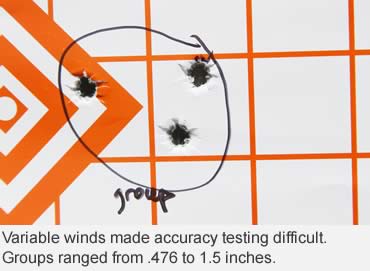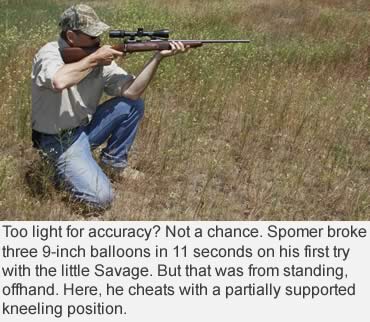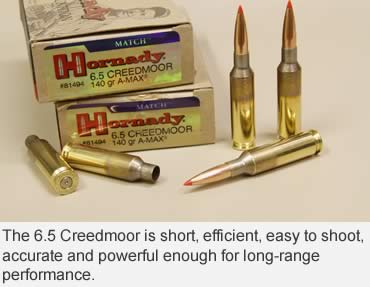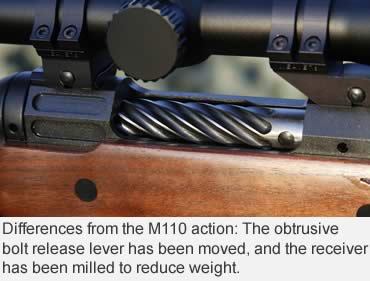This 5.5-pound rifle in 6.5 Creedmoor handles beautifully and was exceptionally accurate in our tests.
Over the last 15 years, Savage has been dead serious about making great rifles — so serious that I’ve wished they’d lighten up.
They have.
New on dealer’s shelves this year is Savage’s second true lightweight rifle, the Model 11 Lightweight Hunter. The short-action version weighs just 5.5 pounds with a 20-inch barrel.
Savage is also making a 6-pound long action with a 22-inch tube, but this is all about the former in the hot, efficient 6.5 Creedmoor chambering.
Savage became a major force in American rifles with the advent of its 1899 lever-action rifle, the first lever repeater to use a stacked magazine, a rotary one with a digital counter showing how many rounds were left. This permitted the use of more efficient, pointy bullets for better downrange trajectory and energy. Such cutting-edge technology made the M99 the high-tech lever rifle of the age.
 Of course, the future of sporting rifles was the bolt action, and Savage appeared to have a winner in this category, too, with its M1920. At roughly 6 pounds, it was definitely lightweight for its era and even for today.
Of course, the future of sporting rifles was the bolt action, and Savage appeared to have a winner in this category, too, with its M1920. At roughly 6 pounds, it was definitely lightweight for its era and even for today.
The M1920, manufactured from that year until 1929, never really caught on. It was first chambered for the trendsetting .250-3000 Savage, a short little deer round that was the first factory load to hit the magical 3,000 fps mark. Alas, it did this with an 87-grain bullet, and a rather fragile one at that, which limited effectiveness somewhat. By the time Savage got around to loading a tougher 100-grain slug, which the inventor of the .250 Savage cartridge, Charles Newton, had wanted all along, other .25s were stealing market share. Ned Roberts’ .257 wildcat and Niedner’s necked-down .30-06 wildcat were building steam.
The M1920 had a slim 22-inch barrel attached to a narrow, trim action apparently tailored to the light-recoiling .250 Savage cartridge. The narrow American walnut stock tapered to a skinny, shallow fore-end terminating in a Schnabel tip that prevented the leading hand from sliding forward off the stock.
 In the latter half of the 1920s, Savage chambered the M1920 in .300 Savage and gave it a 24-inch barrel. This nearly matched .30-06 ballistics in a short-action rifle. The bolt locked with dual front lugs, just like a Mauser. It even had a controlled round feed and a big claw extractor, features that would make the yet-to-be-built Winchester M70 the Rifleman’s Rifle. Yet the M1920 didn’t exactly fly off dealer shelves, so Savage discontinued it.
In the latter half of the 1920s, Savage chambered the M1920 in .300 Savage and gave it a 24-inch barrel. This nearly matched .30-06 ballistics in a short-action rifle. The bolt locked with dual front lugs, just like a Mauser. It even had a controlled round feed and a big claw extractor, features that would make the yet-to-be-built Winchester M70 the Rifleman’s Rifle. Yet the M1920 didn’t exactly fly off dealer shelves, so Savage discontinued it.
It took nearly three decades before Savage unleashed its next high-power bolt action, the flagship M110, still the basis for all Savage centerfire bolt guns. It is much larger and bulkier than the old M1920, but a few unique features like a floating bolt head and barrel lock nut have helped Savage gain a reputation for out-of-the-box accuracy envied by many. And now, 91 years after the introduction of its first true lightweight, Savage has again set a personal low with the M11. But it’s a good low — an easy-carrying lightweight without any reduction in function or accuracy.
Those who know the standard M110 see in it more bulk than absolutely necessary. While the action’s engineering and features do contribute to accuracy, they do it with something less than sleek styling and minimalist accouterments. The overpowering bolt-release lever on the right side of the action has long been visually obnoxious. In the M11, like most of the new M110 actions, it has been moved to a push button lever in the upper front of the trigger bow, where it’s unobtrusive. It now covers the second receiver action screw, too. The famous large barrel-locking nut has been slimmed down, and its deep wrench lugs eliminated, creating a more tasteful barrel/action mating junction.
 Superfluous weight has been milled from the round receiver, flattening it on four sides but leaving the bottom round for simplicity in bedding, the top round so standard scope bases fit. Additional steel has been milled from the left receiver wall and both sides of the rear ring.
Superfluous weight has been milled from the round receiver, flattening it on four sides but leaving the bottom round for simplicity in bedding, the top round so standard scope bases fit. Additional steel has been milled from the left receiver wall and both sides of the rear ring.
There are two emergency gas vent holes on either side of the front ring. Spiral grooves milled into the bolt body shave a half-ounce from it. Two large front gas baffles just behind the recoil lugs block the raceway when the lugs are turned into their recesses. Should any gases escape around these baffles, they are free to escape around considerable space between the bold body and action walls. The rear baffle just in front of the bolt handle is a final, redundant, protective wall against any leaking powder gases.
Weight is minimized in the magazine well by dispensing with the usual steel box, spring, follower and metal floorplate. Instead, a 2.6-ounce steel detachable magazine with a polymer bottom has been adapted from the company’s Axis rifle line. The release latch is integral with the bottom. A polymer frame held in place by the front action bolt and trigger bow captures the magazine.
 I’m not a big fan of detachable magazines, but this one is so light, smooth and easy to load and snap in and out that I give it a thumbs-up.
I’m not a big fan of detachable magazines, but this one is so light, smooth and easy to load and snap in and out that I give it a thumbs-up.
An aid to accuracy is the standard AccuTrigger with its sear-blocking AccuRelease (secondary trigger) within the primary trigger shoe. Until the AccuRelease is pressed out of the way, the sear remains blocked so the firing pin cannot be struck. This enables users to adjust the actual trigger tension as low as 6 ounces on some models, 1.5 pounds on the M11, in perfect safety.
The barreled action is blued, but the finish is a coarse satin. This is great for eliminating glare and minimizing fingerprints, but a bit messier to clean up since the rough finish pulls fibers from some cloths.
I detected rough bolt travel from this finish as the bolt head and short guide lip on the outside baffle lug glide along the action walls. Oil and a bit of friction wear should smooth this out in time.
I also detected a bit of friction with the bolt body spirals riding over the next cartridge in the magazine. Even with this, I was able, from offhand, to break three 9-inch balloons at 25, 50 and 75 yards with three shots in 11 seconds with the M11, suggesting that it is fast and accurate for quick shooting.
 Off the bench, the rifle consistently grouped three Hornady 140-grain A-Max factory loads from .476 inch to 1.5 inches. Average muzzle velocity was 2,725 fps 15 feet from the muzzle. Sighting was done with a Burris Fullfield 3-9x40mm E1 scope. This is stunning accuracy and impressive velocity from a thin, light 20-inch barrel, but it is a Savage and free floating.
Off the bench, the rifle consistently grouped three Hornady 140-grain A-Max factory loads from .476 inch to 1.5 inches. Average muzzle velocity was 2,725 fps 15 feet from the muzzle. Sighting was done with a Burris Fullfield 3-9x40mm E1 scope. This is stunning accuracy and impressive velocity from a thin, light 20-inch barrel, but it is a Savage and free floating.
The American walnut stock has a bit of figure, straight grain, 13.5-inch LOP, straight comb, 1-inch Decelerator pad, sharp and clean 14 LPI checkering and a checkered plastic grip cap with a gold Savage Indian head motif. The fore-end tapers to a narrow, rounded tip. Unique are eight longitudinal holes cut in the fore-end belly to relieve weight. Total rifle weight is 5 pounds, 12 ounces, 4 ounces more than advertised, but expected with walnut-stocked rifles.
One usually thinks of lightweights wearing synthetic stocks. Savage has shown a walnut handle makes a functional, durable classic mate for a light barreled action. The M11 in 6.5 Creedmoor functions perfectly, handles beautifully, is deadly accurate and will make an outstanding hunting rifle.
Read Recent GunHunter Articles:
• The Core-Lokt Stands the Test of Time: Granddad’s ammo saves bucks and still brings home the bucks.
• Know Your Limitations: Don’t attempt a shot in the field you haven’t practiced at the range.
This article was first printed in the October 2011 edition of Buckmasters GunHunter Magazine. Subscribe today to have GunHunter delivered to your home.